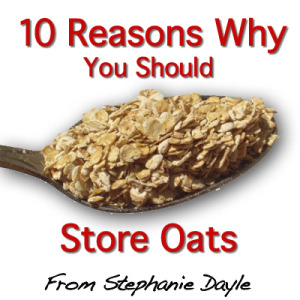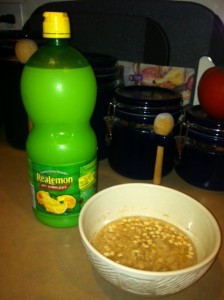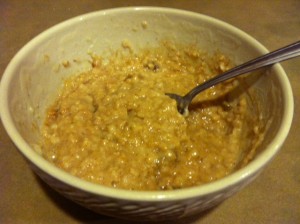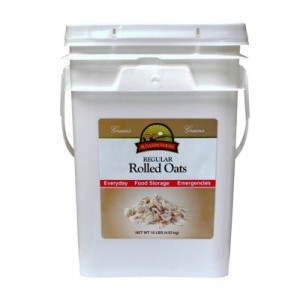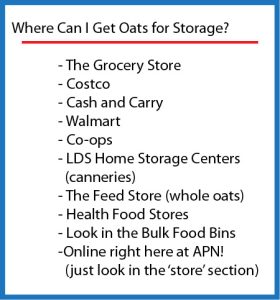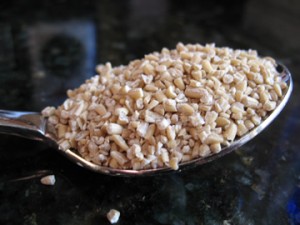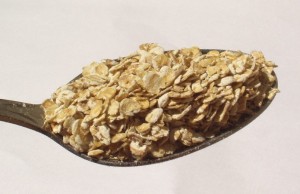10 Reasons Why Everyone Should Store Oats
Oats are one of those storage foods people LOVE to ignore. I can’t even get my own husband to eat them. Since we both came from rural areas and grew up with the same self-reliant and frugal values, I couldn’t understand this. I love oats! Why would anyone not like oats?
Soon I learned it wasn’t just him, but mostly everyone else I ran into. I am convinced that most people who don’t like oats are running into one of two main problems. They never had them prepared correctly to begin with; and/or they just don’t know what to do with them other than make oatmeal. I am going to solve these problems with you today. Oats are an extremely valuable item to put in your food stores and an incredibly healthy addition to your diet and here’s why:
1. Oats: Exceptional Long-Term Storage Option
Oats, especially in their slightly modified form of groats, and steel-cut oats – will last a LONG, LONG time and still deliver life-sustaining nutrition. How long? Studies performed at BYU have shown oats to still deliver “life-sustaining nutrition” for over 30 years if stored correctly. Even the more processed form of Rolled Oats or Traditional Oats will store 20+ years if stored correctly, Provident Living’s website claims 30 years. However, processing oats shortens their storage life, so the more processed they are, the shorter their shelf life.
2. Hassle-Free Oatmeal Preparation Without Electricity
Rolled oats are versatile and easy to cook, offering up several preparation methods. A favored technique involves soaking the oats in water with a minimal amount of lemon juice or vinegar, allowing them to sit overnight. Not only does this enhance their digestibility, but your morning oatmeal can be cooked as swiftly as instant oats, saving on energetic resources.
The Dutch Oven is perfect for slow-cooking both steel-cut oats and rolled oats. Just ensure you have enough water and heat via coal beds, charcoal briquettes, or a wood-fueled kitchen oven. Its lid locks perfectly, retaining moisture to prevent the oats from drying out. It’s also versatile, allowing oats to be used in stuffing recipes like Scottish Haggis or as a binding ingredient.
Oats can also be enjoyed as a drink that has been around for ages and the nice thing about the drink is that you still get many of the health benefits from the oats. You can also use oats to make your own granola as a snack or travel food.
Furthermore, ‘whole oats’ (still with their hulls) hold potential for home sprouting. With only 3 days of sprouting, they become a source of nutrient-dense sprouts.
Enjoy a Sweet Cinnamon Oat Drink using 1 Cup of Old Fashioned Rolled Oats, a 4-inch Cinnamon Stick broken into chunks, 4 Cups of Water, and some Sugar or Honey for sweetness. Soak the ingredients for at least an hour in a pitcher, blend, strain, and sweeten as desired. It’s best served chilled or over ice.
For a culinary delight, try Slow Cooker Oat Meal from Food Network’s Good Eats. Combine 1 cup of steel-cut oats, 1 cup each of dried cranberries and figs (or your choice of dried fruit), 4 cups of water, and 1/2 a cup of half-half in a slow cooker (or Dutch Oven). Set on low heat and it’ll be ready in 8 to 9 hours; stir occasionally and add water if needed. An overnight cook while you sleep ensures warm oatmeal by morning.
3. Oats are Higher in Protein Than Wheat or Rice
Oat protein is 16.9 g to that of even Brown Rice at 7.94 g. Oat protein is almost equal to soy protein, which research has shown is nearly equal to meat, milk, and egg protein (a bonus for those of us who don’t like soy). The protein content of the different forms of oats ranges from 12 to 24%, the highest among cereals making oats an excellent choice to store as a survival food for times when other sources of protein are scarce.
4. Sustained Fullness With Oats
Oats contain more ‘soluble’ fiber than any other grain, resulting in slower digestion and an extended sensation of fullness. Staying fuller longer could come in handy when food is scarce. It is also what makes oats a superb breakfast food, preventing the urge to snack until later on during the day.
5. Oats Will Help Control Blood Sugar and Cholesterol
Oats contain complex carbohydrates which help stabilize blood sugar and the before mentioned soluble fiber slows the absorption of glucose. The soluble fiber in oats has also been proven to lower bad cholesterol (LDL) by essentially taking it out with trash as it moves through and out of your system so to speak. Oats could be one of your only tools in treating someone with high cholesterol in a prolonged emergency when they do not have access to their statin drugs and oats could be one of many dietary tools for helping to manage blood sugar levels (assuming you don’t smother the oats in sugar).
6. Rolled Oats as a Meat Enhancer
During the depression, many families added oats to their meat when grinding and cooking it to make it go further and to keep everyone fuller a little longer. A favorite place to add oats was and still is to meat loaves, as oats tend to take on the flavor of whatever they are cooked with.
7. Oats: A Viable Option Where Wheat Cannot Thrive
Oats are easily grown in temperate regions. They have a lower summer heat requirement and greater tolerance of rain than other cereals such as wheat, rye or barley. They can be grown in areas with cool, wet summers, such as the Northwest. As an example to their hardiness, they are being grown successfully in Iceland. Oats also do not require weeding as they usually choke out most weeds. Whole oats can be planted as seeds.
8. Grounding Oats into Flour: A Practical Option
Groats are a good choice for flour making, but you can also use old-fashioned rolled oats. Rolled oats can be turned into oat flour with a strong food processor while groats will require an actual grain mill. Oat flour adds the health benefit of oats to any baked good. Oat flour, if coming from a wheat-free facility, can also help fill the holes in a gluten-free diet. If wheat becomes more scarce, oat flour may become its substitute.
9. Embrace the Cost-Effective Versatility of Oats
Let’s not overlook the fact that surplus oatmeal is perfect for making nutritious, tasty homemade oat bread. Oats are wallet-friendly, serving as both human food and an animal feed variant. Given their relative affordability, especially considering the protein content compared to other grains, they’re an excellent option for bulk purchasing and food storage.
10. Oats Can Double as an Animal Feed
Cultivated primarily for horsepower, the complex carbohydrates in oats have long been a potent source of livestock energy. Oats can be consumed by various farm animals including horses, cows, dogs (via oatmeal), chickens, goats, sheep, and more.
5 main types of oats and why it matters!
Whole Oats – These oats are usually straight from the field and still have a hull. You usually can only get these from a feed or farm supply store. Unless you have the means to remove the hull I would not recommend getting them unless you want them as animal feed or as seed – if you do buy them and want to use them as food, make sure they have not been treated with any kind of chemicals or poison.
Groats, de-hulled whole oats, can be hard to find but do exist in certain co-ops and health food stores. They can be challenging to cook and may seem tough, but they’re excellent for home ground flour. Using a home grain mill, you can grind them into flour or your own steel-cut oats. If you’re feeling ambitious, try a roller mill or roller mill attachment on your meat grinder or KitchenAid mixer to create old-fashioned rolled oats from groats.
Steel Cut Oats – These are oats that have been cut by steel blades into small pieces. They cook up finer and quicker than groats to make a nice porridge, and many people say that flavor from steel-cut oats is better than the old-fashioned rolled oat porridge we know as “oatmeal.” They are also known as Irish Oats or Pinhead Oats. Cooking time on Steel cut oats is 35-60 minutes if not longer.
Rolled Oats or Old Fashioned Oats – Are a processed version of groats. They are groats that have been steamed and rolled flat to speed up cooking time to around 10-15 minutes in boiling water.
Quick Oats – Once again these are groats that have been steamed, but they have been rolled even thinner to decrease cooking time even more to 3-5 minutes in boiling water. Once oats are processed to this extreme they start losing some of their nutritional value as the processing methods begin to damage the soluble fiber within the oats.
Instant Oats – these are oats, usually quick oats, that have been pre-cooked and then dehydrated. You only need to add hot water to these oats for a finished product. They do not store well at all and are the least nutritious of all the different forms of oats, but they still have a well deserved spot in your Bug Out Bag, or your 72 hour kit. Flavored Quaker Instant Oatmeal is this type of oats.

